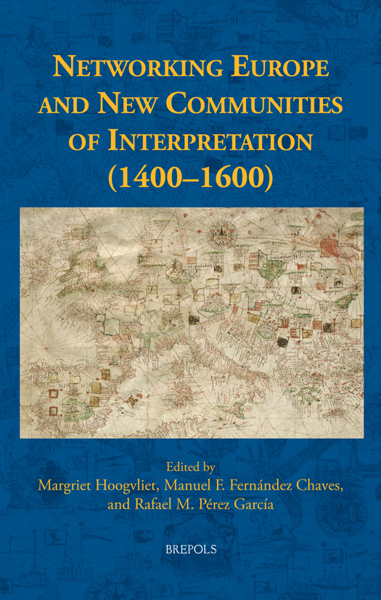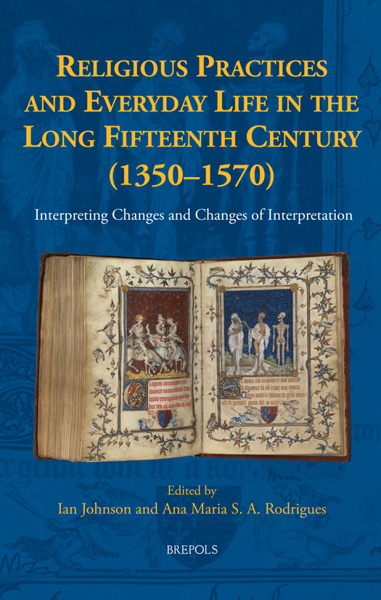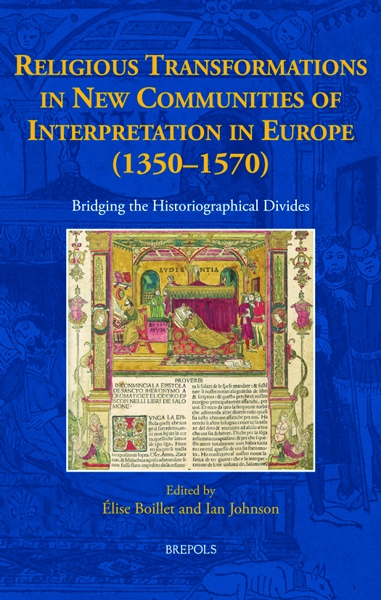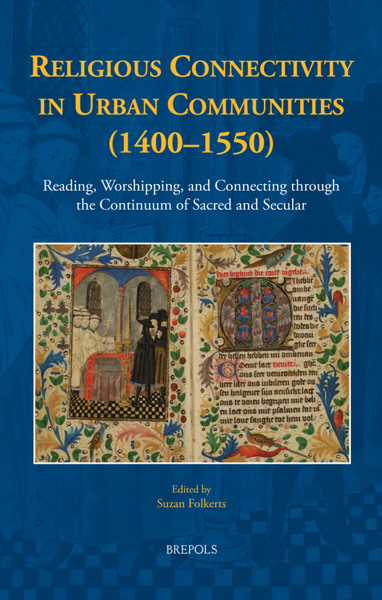
Religious Practices and Everyday Life in the Long Fifteenth Century (1350–1570)
Interpreting Changes and Changes of Interpretation
Ian Johnson, Ana Maria Rodrigues (eds)
- Pages: 418 p.
- Size:156 x 234 mm
- Illustrations:25 b/w, 2 tables b/w., 2 maps b/w
- Language(s):English
- Publication Year:2022
- € 110,00 EXCL. VAT RETAIL PRICE
- ISBN: 978-2-503-59355-5
- Hardback
- Available
- ISBN: 978-2-503-59356-2
- E-book
- Available
Explores change in religious practices in the ‘long fifteenth century’.
“It is mainly Géraldine Veysseyre’s bravura concluding essay that draws together the rich and diverse material offered by the rest of the articles, and that conclusion stands out as not just the most important part of the volume but a key to the significance of those individual contributions.” (Richard Kieckhefer, in The Medieval Review, 02/08/2023)
« La richesse des 15 contributions, soulignée dans la conclusion (Géraldine Veysseyre), nous permet d’approcher la vie religieuse quotidienne à la fois des communautés et des individus qui les composent et les fabriquent, se basant sur des sources originales, originaires d’espaces pour l’instant encore souvent sous étudiés et sous-représentées dans des ouvrages sur l’Europe médiévale. L’analyse pertinente de documents textuels et iconographiques (le livre contient 25 images commentées dans 6 contributions) mais aussi d’éléments de la culture matérielle médiévale, qu’il s’agisse des manuscrits pris en tant qu’objets que d’autres objets tels que les rosaires p. ex., permettent d’éclairer notre connaissance des contextes sociaux, culturels et matériels des pratiques religieuses durant le long 15e s. » (Ninon Dubourg, dans Revue d'Histoire ecclésiastique, 119/3-4, 2024, p. 799)
Ian Johnson is Professor of Medieval Literature and Head of the School of English at the University of St Andrews. He was Co-Director of the Queen’s Belfast-St Andrews AHRC-funded project Geographies of Orthodoxy: Mapping English Pseudo-Bonaventuran Lives of Christ, 1350-1550 (2007-11). With Alastair Minnis he edited The Cambridge History of Literary Criticism: Volume II. The Middle Ages (2005). He is founding General Editor of The Mediaeval Journal (Brepols) and was for many years General Editor of Forum for Modern Language Studies (OUP). His latest books are The Middle English Life of Christ: Academic Discourse, Translation and Vernacular Theology (Brepols, 2013); The Pseudo-Bonaventuran Lives of Christ: Exploring the Middle English Tradition, edited with Allan Westphall (Brepols, 2013); The Impact of Latin Culture on Medieval and Early Modern Scottish Writing, edited with Alessandra Petrina (Medieval Institute Publications, 2018), and Geoffrey Chaucer in Context (CUP, 2019). He was a Working Group Coordinator and Management Committee member of the COST Action New Communities of Interpretation: Contexts, Strategies and Processes of Religious Transformation in Late Medieval and Early Modern Europe (2013-17).
Ana Maria S. A. Rodrigues (MA Sorbonne; PhD University of Minho) is Associate Professor at the University of Lisbon. Previously, she lectured at the University of Minho. She has written extensively on economic and religious history. Her most recent publications concern medieval monarchy and gender: A. M. S. A. Rodrigues, M. S. Silva, and J. Spangler (eds), Dynastic Change: Legitimacy and Gender in Medieval and Early Modern Monarchy (London/New York, Routledge, 2019}; ‘The Crown, the Court and Monastic Reform in Medieval Portugal: A Gendered Approach’, in Queens, Princesses and Mendicants: Close Relations in a European Perspective, edited by N. Jaspert and I. Just (Zurich: Lit Verlag, 2019), pp. 53-63; ‘Spirituality and Religious Sponsorship in the 15th-century Portugese Crown: Kings, Queens and Infantes’, in Women’s Networks of Spiritual Promotion in the Peninsular Kingdoms (13th-16th Centuries), edited by B. Gari (Barcelona/Roma: IRCVM/Viella, 2013), pp. 205-20.
The essays in this book bring to light and analyse the continuities and shifts in daily religious practices across Europe — from Portugal to Hungary and from Italy to the British Isles — in the transition from the Middle Ages to the early modern period. While some of these changes, such as the increasing use of rosaries and the resort to Ars Moriendi, were the consequence of the rise of a more personal and interiorized faith, other changes had different causes. These included the spreading of the Reformation over Europe, the expulsion or compulsory conversion of the Jews in the Iberian Peninsula, and the conquest of large portions of eastern Christianity by the Turks — all of which forced people, who suddenly found that they had become religious minorities, to adopt new ways of living and new strategies for expressing their religiosity.
By recovering and analysing the cultural dynamics and connections between religious power, knowledge, culture, and practices, this collection reconsiders and enriches our understanding of one of the most critical phases of Europe’s cultural history. At the same time, it challenges existing narratives of the development of (early) modern identities that still, all too often, dominate the self-understanding of contemporary European society.
Introduction
Interpreting Changes in Daily Religious Practice and Changes of Interpretation in the ‘Long Fifteenth Century’ — IAN JOHNSON AND ANA MARIA S. A. RODRIGUES
Religious Practices and Everyday Life: The Monastic Experience
Religious Practices of the Canons Regular of St Augustine in the Czech Lands: The Statutes of Roudnice — ADÉLA EBERSONOVÁ
The Devotional Book in Context and Use: Catalan Poor Clares and English Birgittines: Spaces, Performance, and Memory — BLANCA GARÍ, NÚRIA JORNET-BENITO, AND DAVID CARRILLO-RANGEL
Literacy, Books, and the Community: Textual Evidence from a Portuguese Dominican Nunnery — GILBERTO CORALEJO MOITEIRO
Religious Practices and Everyday Life: The Laity
Change and Continuity in Lay Devotion as Evidenced by Prayer Beads in Medieval Poland and Central Europe — MONIKA SACZYŃSKA-VERCAMER
A Daily Devotion of the Long Fifteenth Century: Italian Literature on the Rosary — ERMINIA ARDISSINO
The Prayer Book of George of Poděbrady and Books of Private Devotion in Post-Hussite Bohemia — JAN DIENSTBIER
The ‘Goostly Chaffare’ of Reginald Pecock: Everyday Craft, Commerce, and Custom Meet Syllogistic Polemic in Fifteenth-Century London — IAN JOHNSON
The Reformation and the First Book in the Lithuanian Language — DALIA MARIJA STANČIENE
Preparing for Death and the Afterlife
‘The Kingdom of Heaven cannot be denied to you justly because you have fought correctly’: Tracing the Evolution of Ars moriendi Literature in the Fifteenth Century — JOOST ROBBE
Caxton and the Reception of the Artes moriendi — DELPHINE MERCUZOT
Death Multiplied: The Legend of the Three Living and the Three Dead in Bohemian Art in the Context of Late Medieval Religious Practice — DANIELA RYWIKOVÁ
De praeparatione ad mortem: The Dying and Death of Charles V (1500–1558) — NIKOLA SAMARDŽIĆ
Continuity and Change in Religious Practices: Christianity and Islam
The Phenomenon of Crypto-Christianity in the Balkans during the Sixteenth Century — VLADIMIR ABRAMOVIĆ AND HARIS DAJČ
Traditions and Transitions: Examples of Parallel Practices in a Sixteenth-Century Central European Region — MARCELL SEBŐK
Continuity and Discontinuity in Everyday Religious Life in Southern Hungary before 1526 in the Light of Supplications to the Holy See — MELINA ROKAI
Conclusion
Books and Objects Supporting Quotidian Devotion: Conclusions and Prospects for Investigating Daily Religious Practices during the ‘Long Fifteenth Century’ — GÉRALDINE VEYSSEYRE
***
Index



